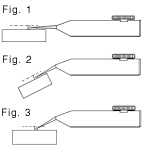Columns
Inspecting Tapers, Part 2: Toolholder Gaging
A few months ago, we discussed the calibration of conical taper masters, which are used to master taper gages. Now let's look at the parts those gages are used to inspect—toolholders.
Read MoreAssessing Gage Stability
Gage stability implies different things in different contexts. If taken literally, it may refer to whether there is something loose on the gage, or some other gage problem occurs randomly, to cause two identical trials to produce different results.
Read MoreWhich Is Faster, G00 or G01?
Special thanks to Kyle A. Thornley, Technical Instructor at GE Fanuc Automation, for explaining the principles described in this article.
Read MoreA Tool To Help With Jaw Boring
Machining soft jaws remains one of the most tedious and time-consuming tasks for turning centers, so anything you can do to organize and simplify this task will speed up your setups. In order to make the workholding setup when soft jaws must be machined, the setup person must remove the current top tooling from the chuck, find the set of jaws to be used for the new setup, mount the jaws to the chuck, clamp on some form of temporary plug or ring, and machine the jaws.
Read MoreGaging 'Relational' Dimesions
Specifications often require inspection of dimensional relationships between two features, or between two dimensions on the same feature. Compared to single-dimension specifications (such as diameter), these "relational" specifications can be challenging to inspect.
Read MoreHow to Correct for Cosine Error
A small shopfloor network lays the groundwork for large-scale, low-cost DNC throughout a major manufacturing facility.
Read MoreEliminating Calculations For Offset Entries
Almost every offset entry requires some kind of calculation to be made before the offset value can be entered. Say, for example, the target diameter for a turning tool is 3.
Read MoreWhen Indicators Go Both Ways
Measuring and gaging are two fairly distinct forms of dimensional inspection. Measuring is a direct-reading process, in which the instrument incorporates a continuous scale of units, against which the part is compared directly.
Read More













